Hiroshimas
TANAKA Hironobu

Hiroshima Station
Summer is here. I visit Hiroshima.
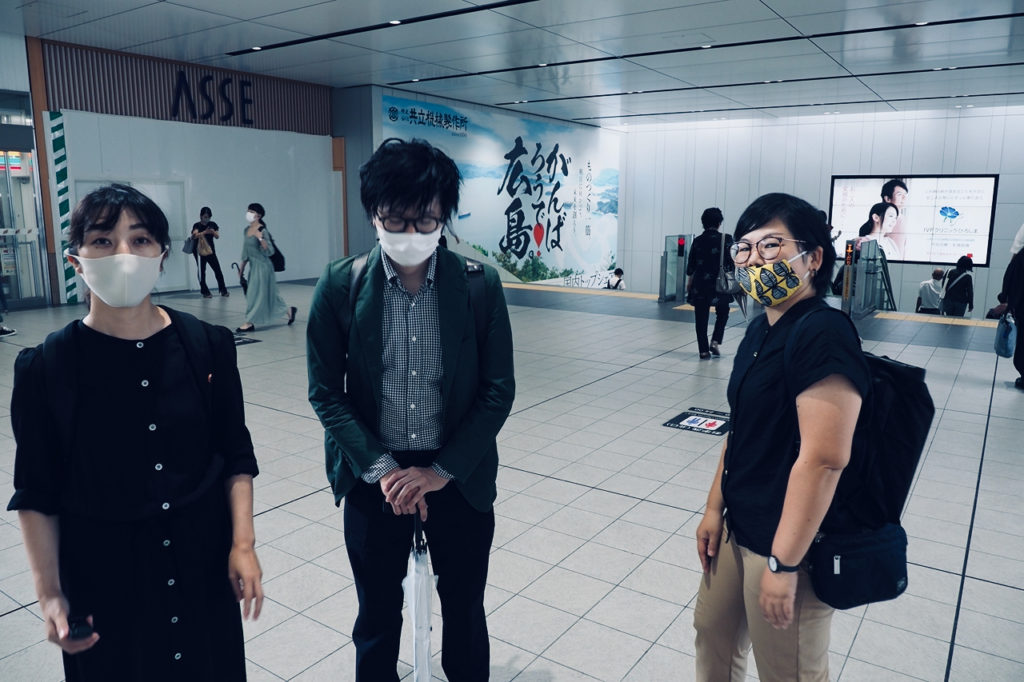
Before even falling asleep, the bullet train, Shinkansen, arrived at Hiroshima Station from Osaka, where I live. There I met up with Ms. Imai, Mr. Araki, and Ms. Koshobu, an official of the Hiroshima Prefectural Government, who showed me around.
My father was born in Onomichi City, Hiroshima Prefecture, in 1926. In 1943, he began working as a steam locomotive engineer in the Itozaki Engine Depot of the Ministry of Railways.
When I told them about this, Ms. Imai and Mr. Araki invited me to come to Hiroshima in the summer of 2020 to see the city. Ms. Imai and Mr.Araki work for an advertising company in Fukuoka. Mr. Araki had recently been transferred from Hiroshima to Fukuoka.
The four of us, and everyone else in town wore masks. This is the reality of 2020. I had no idea that the world would be like this. We decided to walk around Hiroshima.
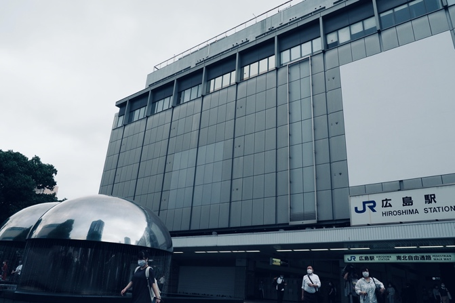
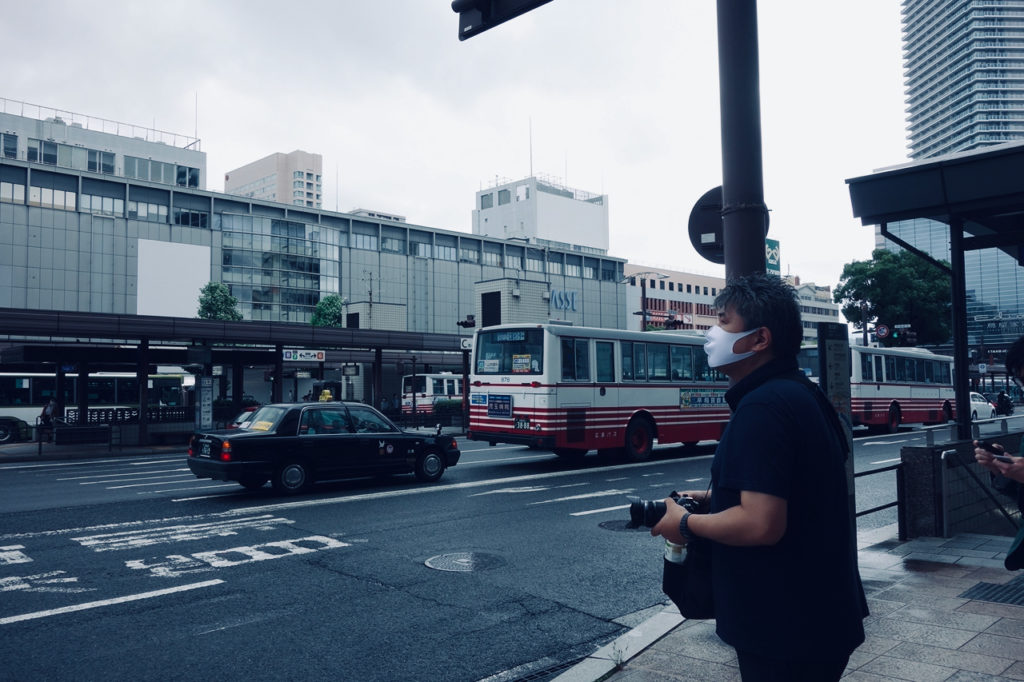
We looked at Hiroshima Station from the outside. I couldn’t forget the picture that was displayed at the station when I was here before.
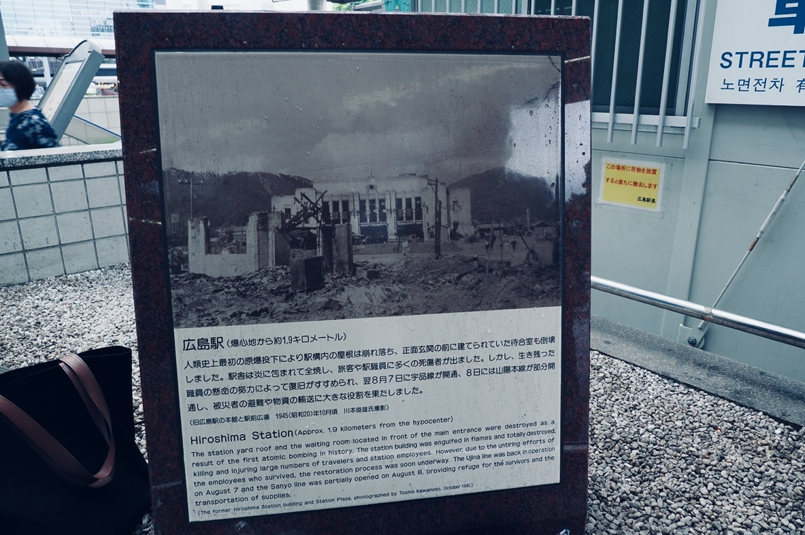
The station building, barely standing amidst the rubble, was very different from the one I was looking up at.
On August 6, 1945, the world’s first atomic bomb was dropped on people alive.
The Japanese National Railway Workers Union’s “This Anger, Vol. 8” tells of the devastation of this place, 1.9 kilometers from the hypocenter.
“In Hiroshima Station, a large number of passengers were trapped under the crushed wickets in front of the station’s main building. The annex housing the stationmaster’s office was destroyed and the two-story conductor’s area was also crushed. Those on the platform were blown away by the blast to the platform across two tracks. Most of the pillars of each platform’s shed were broken, twisted or collapsed over the tracks.”
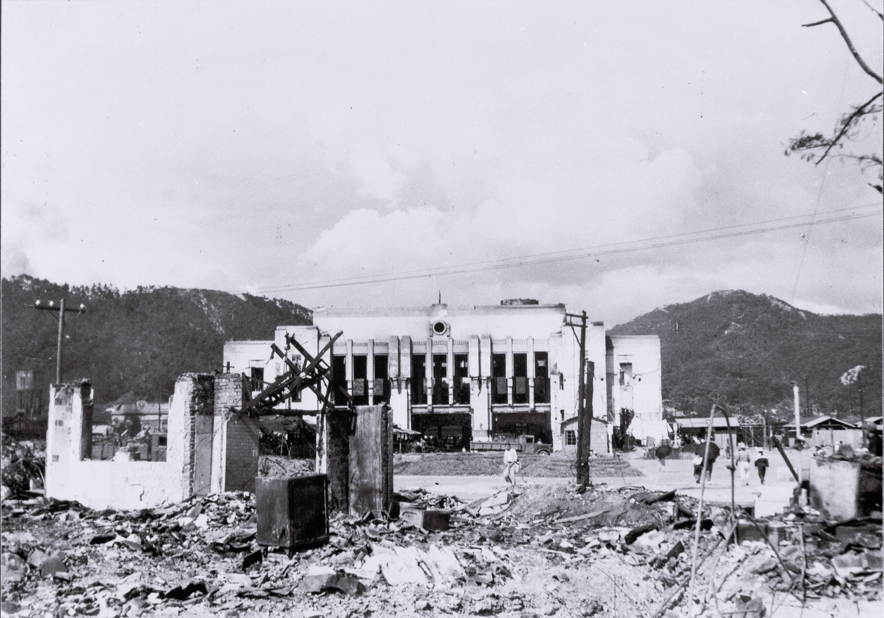
The journal of the Hiroshima Railway “Hiroshima No. 34,” described the devastation of Koi Station, now Nishi Hiroshima Station. It was just as far from the hypocenter as Hiroshima Station.
“Koi Station was the western entrance to Hiroshima City, and thousands of victims rushed up and down through the station grounds. The women were particularly tragic, with clothes stripped off by the blast and nearly naked, their hair burnt off and their torn skin hanging down over their bodies like rags. There were people hurrying around frantically, some drifting about like sleepwalkers, and others huddled on the railroad tracks with their eyes blinded and unable to see.”
My father was working on the locomotive in the Itozaki Engine District that day. As it happened, coincidentally, there was no work at Hiroshima Station, so he could avoid the disaster. But after the bombing, he made several trips to Hiroshima Station and back.

However, no matter how many times I asked him what he had seen there, he never told me anything about it.
He often told me about the time before the bombing.
“Around the end of July, there was a rumor that a new type of bomb had been made in the United States. It was said they might be dropping it soon, so we trained to withstand the bomb. We were made to practice holding our eyes, nose and ears with our hands and holding our breath, so we wouldn’t die even if it flashed.” he said.
Then my father laughed and dexterously put his fingers in his ears and nose and made a gesture to get down.
“It was impossible to prevent anything by that. After Pica* fell…” (*Pica: A slang word for atomic bomb, memetric wording from its strong light flash. This name was widely used then because there was no concept of “atomic bombs.”)
Then, invariably, my father’s words always stopped there. It was a gesture exactly like my maternal grandfather, called up to the Navy.
My grandfather became a member of the crew of a transport, but his ship sank in the South Seas and only a few of the 200 men on board happened to be rescued and returned home. I heard about it from someone who had been my grandfather’s comrade in arms. He never talked about it for the rest of his life, and passed away.
My father also passed away 19 years ago. My father, who went both ways from Itozaki to Hiroshima every day, and my grandfather, who was one of the few people out of 200 who were pulled out of water, both had a narrow escape from death.
I would have liked to hear more from both of them while they were still alive. But they probably wouldn’t talk about it, no matter how hard I asked.
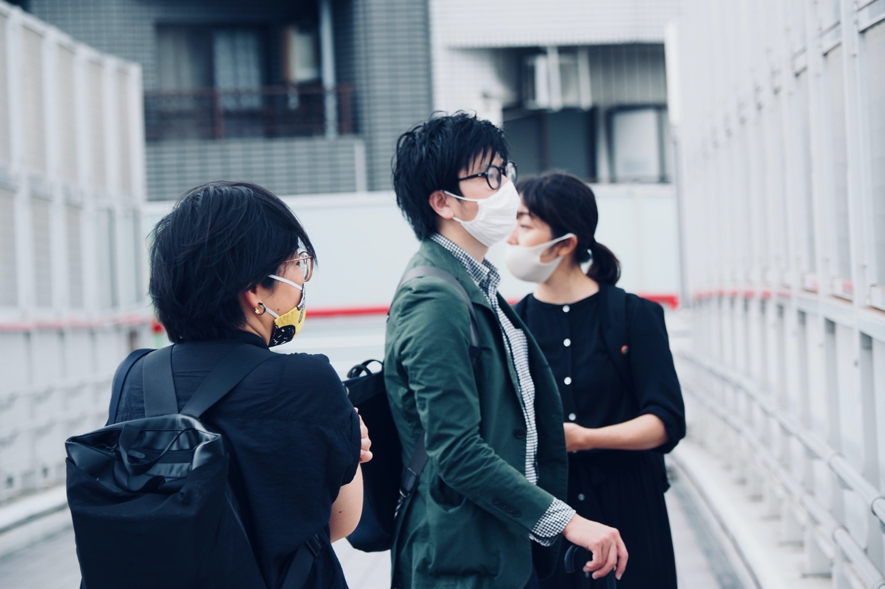
Mr. Araki lived in Hiroshima for three years. Ms. Koshobu says,
“My parents and my grandparents have lived in Hiroshima for generations. Now that I’m working for the Hiroshima Prefectural Office, I have thoughts about many things.”
We looked into the distance thoughtfully. That day, the railroad tracks connected Hiroshima with the city beyond.
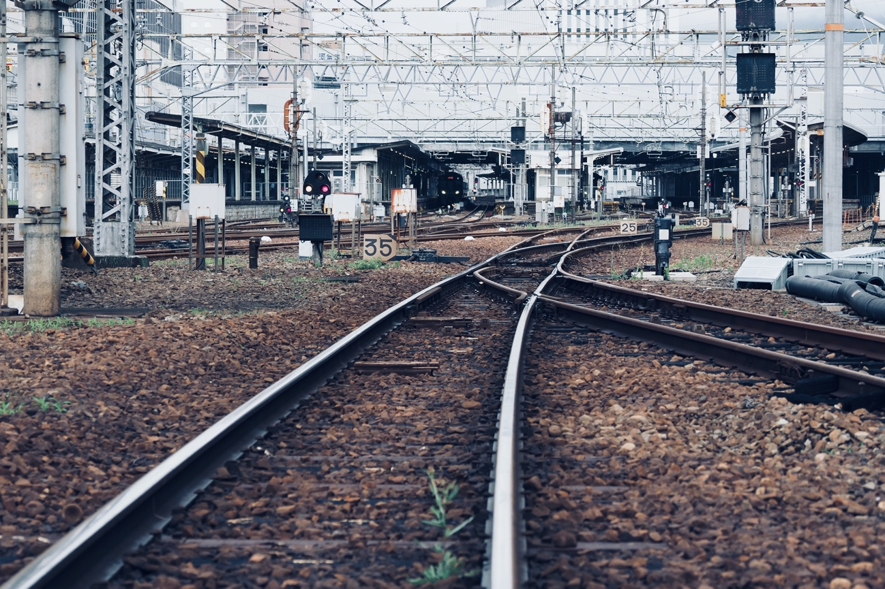
This journey would become a dialogue between I and my father, who can no longer speak. It would be a journey to see exactly what he had seen in Hiroshima.

the Hiroshima Castle
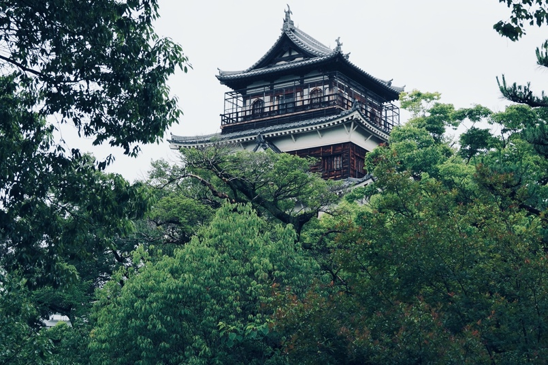
There was another building I was curious about: the Hiroshima Castle. The present-day Hiroshima Castle was rebuilt with reinforced concrete. In the war, the castle tower, once had been a national asset, collapsed in an instant.
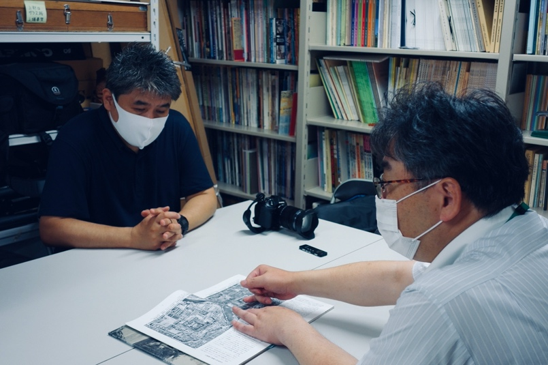
We spoke to YAMAWAKI Kazuyuki, a curator of Hiroshima Castle.
Tanaka: I didn’t have any questions about Hiroshima castle, which seemed to be kept intact, but I heard it was actually blown out by the atomic bombing. I don’t think the story of the castle is widely known. What happened to the castle during the war?
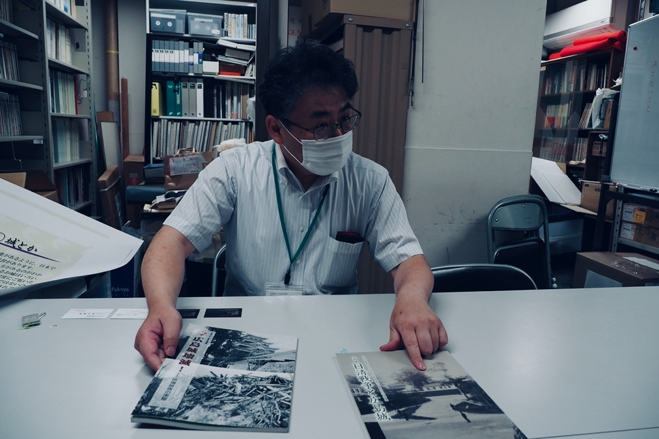
Yamawaki: The tower of Hiroshima castle had been designated as a national asset. People often misunderstand that the castle was burned down by the bombing, but it was actually blown off by its blast. It was reported that people heard the sound of wood thumping down from the mountain.

Yamawaki: This is the remains of the castle tower. It turned into rubble. But from autumn to winter, the rubble cleared out.
Tanaka: Where did it all go?
Yamawaki: Well, this is just my guess, but the whole city area was burned-out and nothing left, so the wood may be used to build barracks; Then winter came, it got colder and colder, and the timbers were used as fuel.
Tanaka: How far was the castle from the center of the explosion?
Yamawaki: It was within a kilometer. The shock wave comes before the heat wave. That’s why it collapsed.
Tanaka: I have heard that the United States killed and injured civilians in air raids and atomic bombs, but did not target national treasures or cultural assets so much.
Yamawaki: Well, I’m afraid it’s not so. Hiroshima Castle surely was a target for bombing. The Army had fortified around the castle. Many of the castles were in similar situations; they were used as military facilities, so it was definitely a target for attack.
Tanaka: It was in the middle of the war, so they didn’t think of it as a cultural asset or anything like that.
Yamawaki: Look at this picture. This was a picture taken by the U.S. military on July 25, 1945.

Tanaka: That was only about ten days before the bombing, wasn’t it?
Yamawaki: That’s right. The Japanese army had no air control at all.
My father saw the flames of the Fukuyama air raid on August 8, after the atomic bombing (Aug. 6). He wrote he could see the flames from the top of the hill in Onomichi City (his house was in Onomichi). He left a diary writing on that scene.
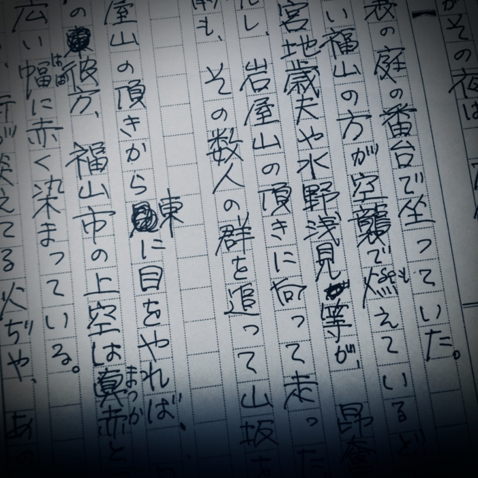
On the evening of August 8, I was sitting on a bench in the front yard of Ohara’s house.
“Look! The air raids are burning Fukuyama!”
The crowd of men, including MIYAJI Toshio and MIZUNO Asami, ran toward the top of Mount Iwaya-yama, with their agitated voices.
Following the crowd, I climbed up the mountain slope and looked eastward to see the sky over Fukuyama City, which was completely lit in red.
Mizuno said, “That is fire burning people. People are in the fire. Pica* got Hiroshima, and B-29 air raid on Fukuyama. Next is Onomichi.”
(*atomic bomb: please refer to previous annotation)
My father, who kept a diary in such detail, left nothing about what he saw in Hiroshima. In the Fukuyama Air Raid, the tower of Fukuyama Castle, a former national asset, was lost. Other castles in Japan, including Nagoya Castle, Wakayama Castle, the castle tower at Ogaki Castle, and the third-story turret at Mito Castle were also destroyed in air raids.
In fact, the initial target of the atomic bomb was Kyoto where numerous ancient temples, shrines, and other cultural buildings stand. This is neither conjecture nor falsehood. As an official U.S. document, it is open to anyone wishing to read.
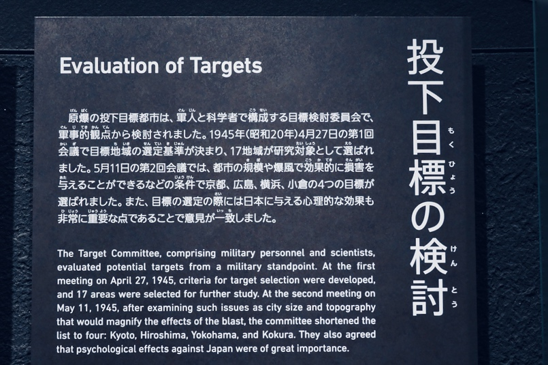
Source: Hiroshima Peace Memorial Museum
There is no preservation of cultural property in war. There is no preservation of history. There is only destruction.
Mr. Yamawaki and I climbed the castle tower.

Tanaka: When was this castle tower built?
Yamawaki: In the 1950s, there was a period of rapid economic growth. The “Hiroshima Reconstruction Exposition” was held, and it was planned to restore the castle to its former form. It was completed in 1958, so the castle’s more than 60 years old.

Yamawaki: You can see the Atomic Bomb Dome from the top floor.
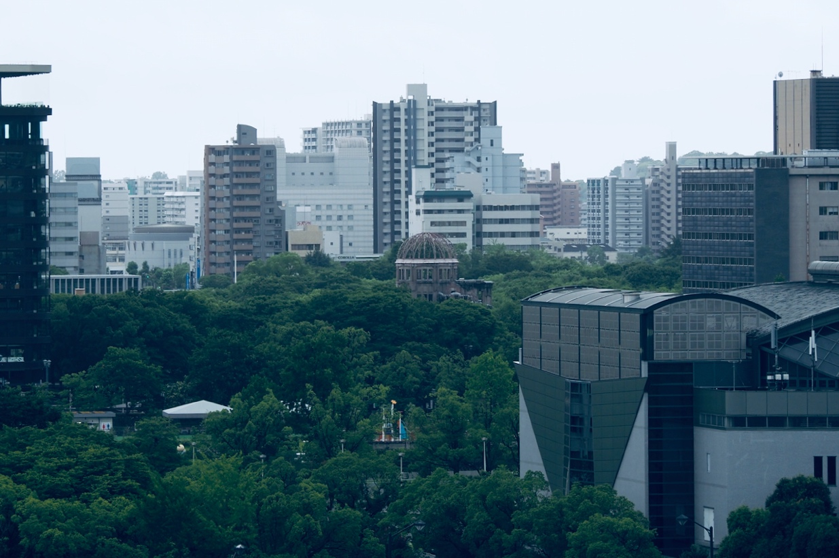
Yamawaki: I’m from the east part of Hiroshima Prefecture. So I don’t have any relatives who faced the atomic bombing. As I didn’t hear about the bombing, I tell the stories that are written in books.
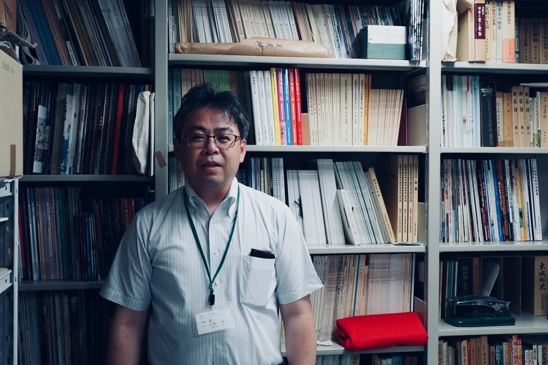
Yamawaki: Near the exit of this castle, there is a tree that survived the day and is still alive. Please take a look at it.
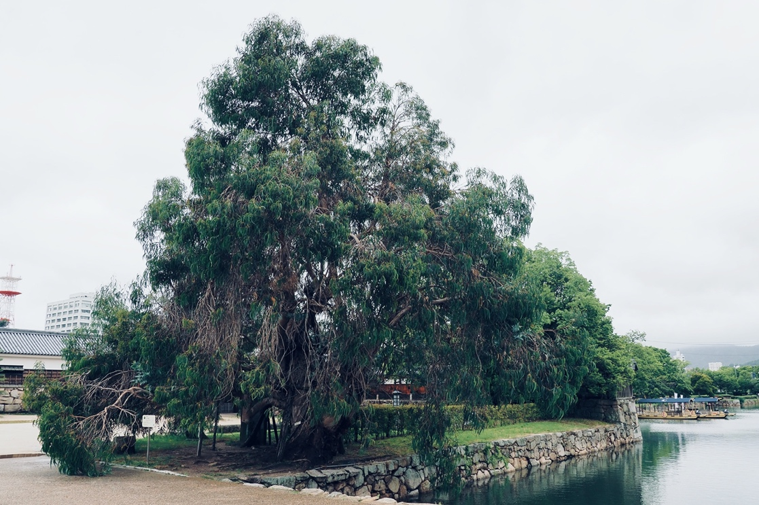
The eucalyptus tree, which had survived the shock waves and heat rays in the summer seventy-five years ago, is still growing its leaves.
The summer of the 75th year is coming to the city where it was said, “No plants or trees will grow for 75 years.”
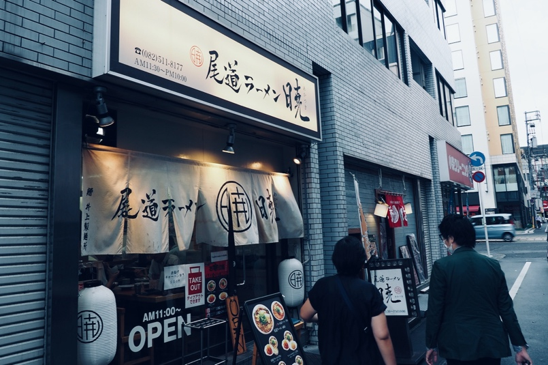
We had Onomichi Ramen for lunch. My father was born and raised in Onomichi, so Mr. Araki guided me to the restaurant.

The salty soup reminded me of my father. I wondered if my father, who served in Hiroshima, had seen the fallen Hiroshima Castle with his own eyes.
Hiroshima Peace Memorial Museum

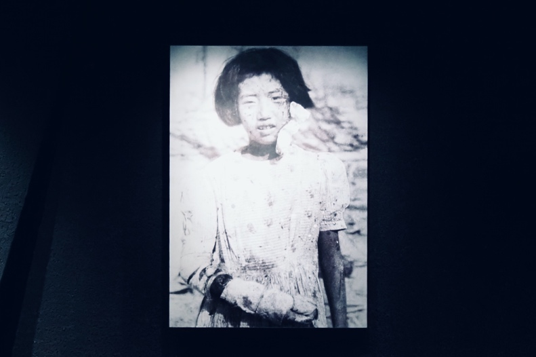
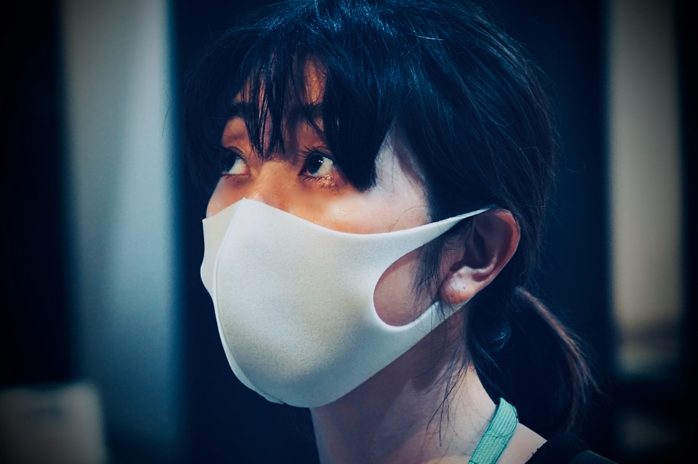

Ms. Imai and Mr. Araki were speechless. I was at a loss for words as well. I had planned to ask many questions and listen to stories as we walked around the Hiroshima Peace Memorial Museum, but I couldn’t find any words to say.
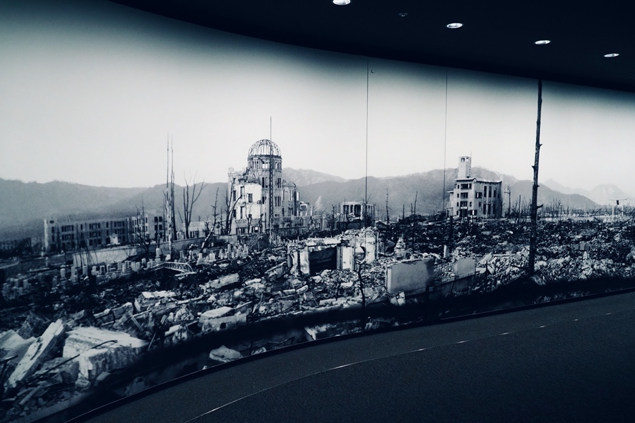
Ms. Kurihara of the Hiroshima Prefectural Government joined us from here. But under our tense atmosphere, we couldn’t say a word.

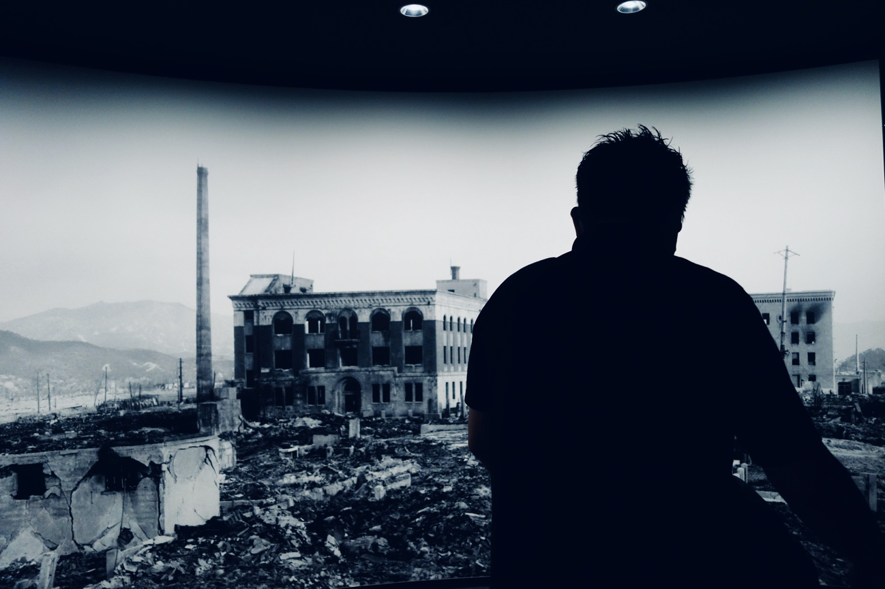
Surrounded by the destroyed streets of Hiroshima, I looked around and put myself on that day. We looked around the exhibition, and no one spoke. Later, we asked Ms TANIMOTO Mayumi, at the Hiroshima Peace Memorial Museum.

Tanaka: We had planned to ask you a lot of questions as we walked around the exhibition, but we were barely able to stand, and there was no conversation between us.
Tanimoto: Yes, yes. I see.
Tanaka: I visited in 2016, but it has changed a lot. When someone asked me how the exhibition was, I said that I was scared of the dolls. I guess I was afraid of the dolls just because they look scary, not because of what really happened to them.

Tanimoto: There used to be a doll exhibit. But on this renewal, the exhibition focuses on real-life materials such as artifacts.
Tanaka: If there had been dolls in this new exhibition, it would have felt unintegrated. It seems the new exhibit is designed to show the actual faces of victims.
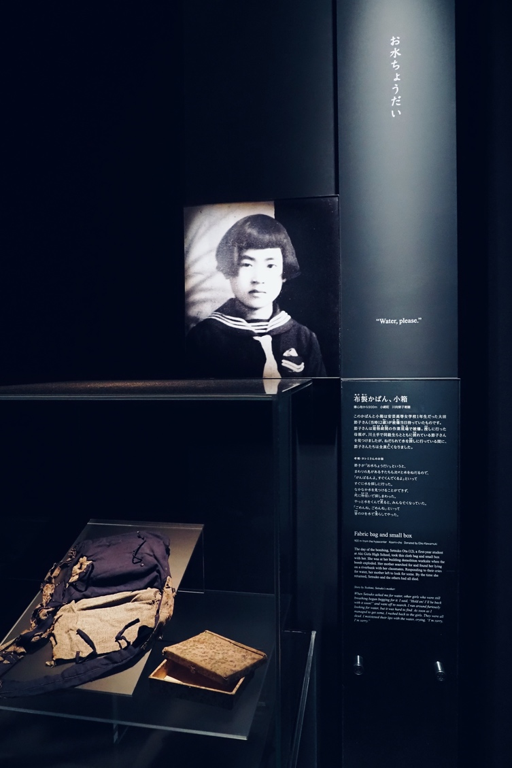
Tanimoto: I believe displaying the names and faces of the victims alongside their belongings would make the visitors feel closer to them as if they were your relatives or acquaintances.
Tanaka: As for black and white photos and artifacts, at first I didn’t think they would be enough to convey the horror. But as I saw them one by one with captions, they came closer and closer to my heart in detail.
Tanimoto: Most of the photos are black and white, and as far as color is concerned, they are accompanied by pictures drawn by the survivors themselves. Near the photos are pictures of people with burns, and if there is a photo of an eye being treated, there is a picture of a person with an eye injury. By seeing them together, it is easier to imagine the devastation of those days.
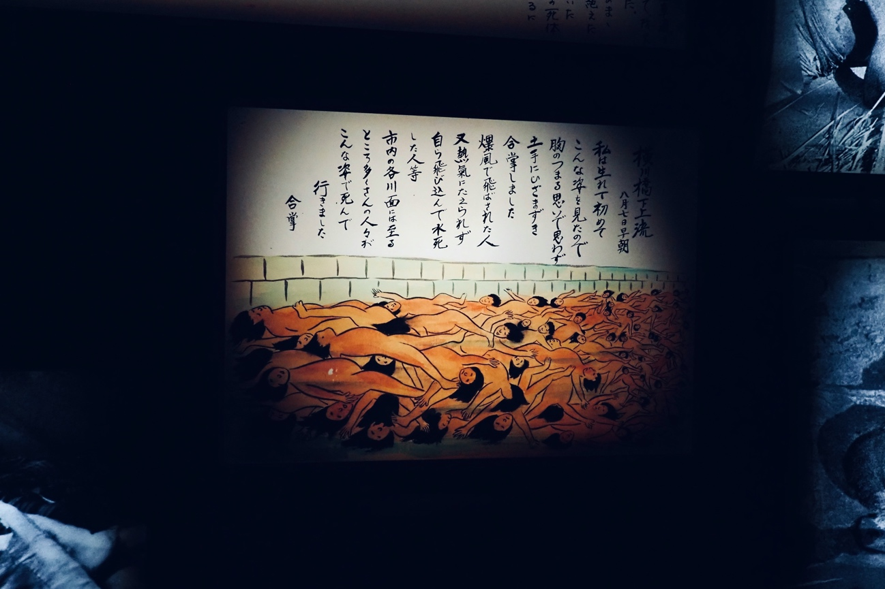
Tanaka: That’s why there are alternating pictures and photographs.
Tanimoto: We exhibit a set of names and faces, the words of the deceased and their family members, and a set of artifacts, focusing on each person.
Tanaka: Yes, it touched me deeply, and I was able to think of it as a personal experience for me and my family.

Tanimoto: At the end of the corridor leading to the main building, there was a photograph of a girl, then 10 years old, standing in the ruins of the fire.
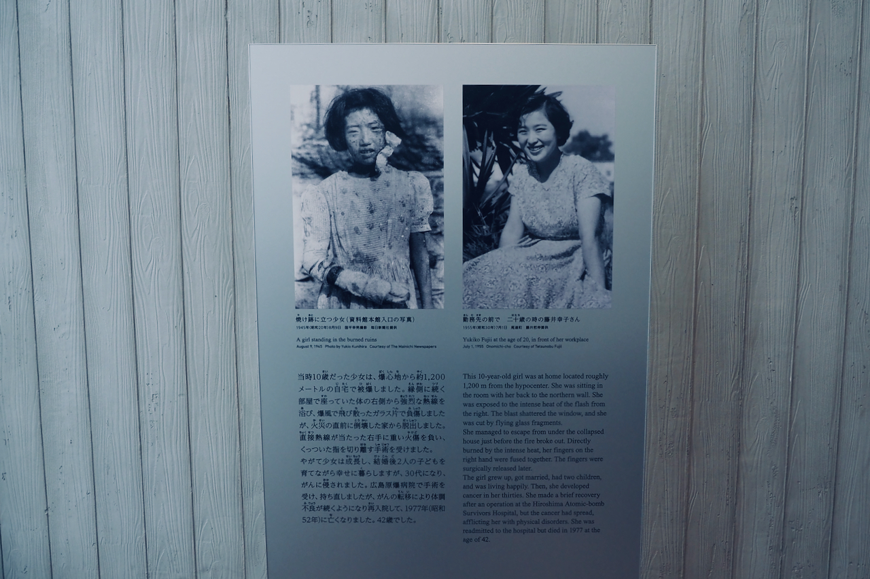
Tanaka: The photo of this girl was placed at the end of the museum, alongside a picture of herself being happy after war. I thought, “Oh, thank goodness the war is over, and she lived happily,” but then the last two lines of the description hit me. It said she died of cancer at the age of 42.
Tanimoto: Right. She lived with health concerns all through the post-war years.
Tanaka: Another person, SASAKI Sadako, who died in 1955, was also new to me.
Tanimoto: Her story is famous overseas. She was two years old when she was exposed to the atomic bombing, and she lived very healthy afterwards. However, she died of leukemia ten years later. When she became ill, she said to her parents, “Sadako has no devotion to parents, spending so much money on my illness.”
Tanaka: …. (*cannot say a word)
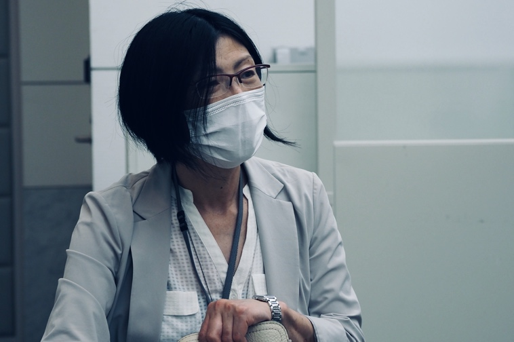
Tanaka: ….
Tanaka: I want to share, little by little, what I felt today, even if it’s just in fragments.
Tanaka: ….
My sobs were in the audio of the IC recorder.
Tanaka: “Creating a World of Peace” is emphasized in the East Building, isn’t it? It conveys the world’s efforts to abolish nuclear weapons.
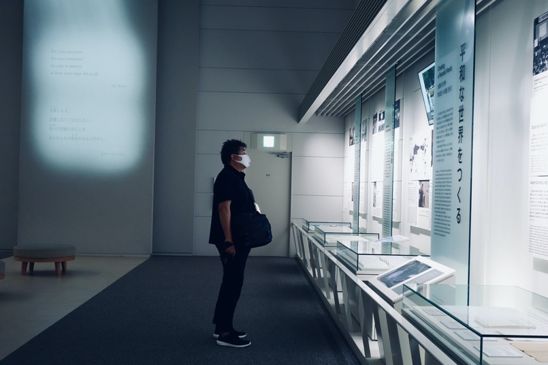
Tanimoto: In the near future, there will be no more people actually experiencing the atomic bomb. How can we convey the damage when there’s no one to talk about the actual experience? How can we convince people of the goal of eliminating nuclear weapons? That is our challenge.
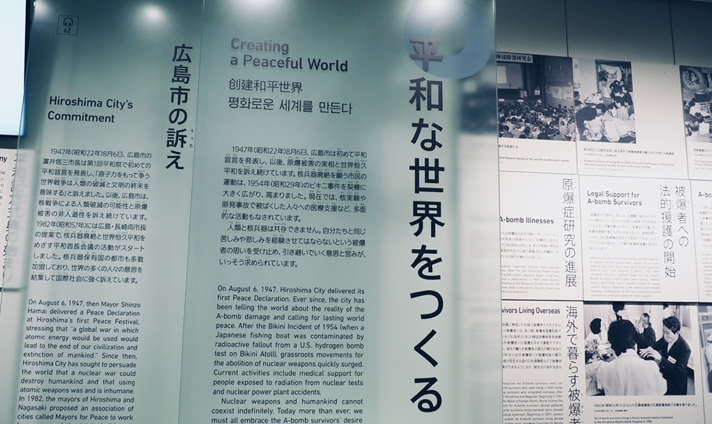
There’s a word: “peace-obsessed.”
Some people say that nuclear weapons are necessary because they have a deterrence. Others say that the existence of nuclear weapons is the reason for world peace. In some opinions, “Japan should arm itself with nuclear weapons.”
People like them deny the opinion of those who disagree with them.
In one respect, it might be. It may be right. But in a world where there is even one nuclear weapon and someone with the authority to launch it, what kind of guarantee is there of “deterrence”?
I was born in 1969 and spent my childhood in the middle of the Cold War. In the movies and cartoons, the image of the final war was repeatedly amplified. Prophecies of the end of humanity were circulated, and I never doubted them. I grew up in fear of the end of the world, believing that the day would surely come.
Just before the fall of the Berlin Wall and the dissolution of the Soviet Union, there were actually 70,000 nuclear weapons in the world.
People have been negotiating to reduce that number, but there are still 13,400 nuclear weapons in the world today.
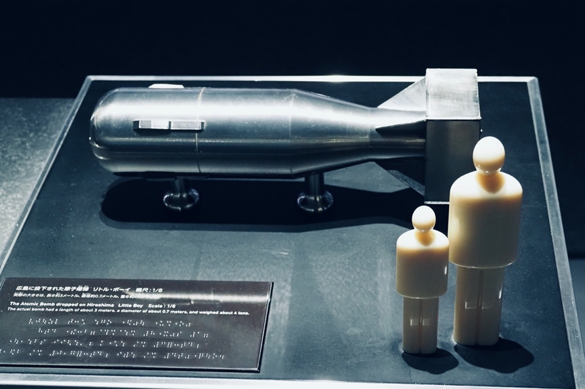
Without any warning, a single atomic bomb was dropped on Hiroshima. A world with a nuclear weapon is a world we can die without warning.
Those who call others peace-obsessed are “war-obsessed.” Do you know war? Have you seen it? Do you know what would happen if nuclear weapons are used? That kind of person cannot even imagine the death of themselves or even relatives. I want them to wake up from that kind of “war-obsession.”
Lisa Feldman Barrett, a Canadian psychologist, proposes that “core affect” and “simulation” of concepts are responsible for human emotions.
According to the core affect theory, when we encounter a stimulus or situation, we remember past experiences (autobiographical memories) or sensory stimuli and sensory aspects (visual, auditory, tasting, touching, and smelling sensations) associated with the stimulus or situation, and represent them in our consciousness. These representations of consciousness simulate and foresee the present sensations, perceptions, subjectivities and behavior, or even the future.
That is to say, human beings perceive the present moment based on their past experiences of being sad, painful, or happy, and furthermore, they simulate the future. The “present mood” consists of two sides of time, the past and the future. That is why human beings are able to empathize with others separated by both time and space.
What happened under the mushroom cloud.

Lack of imagination is what will set off the next atomic bomb.
Ms. Imai speaks.
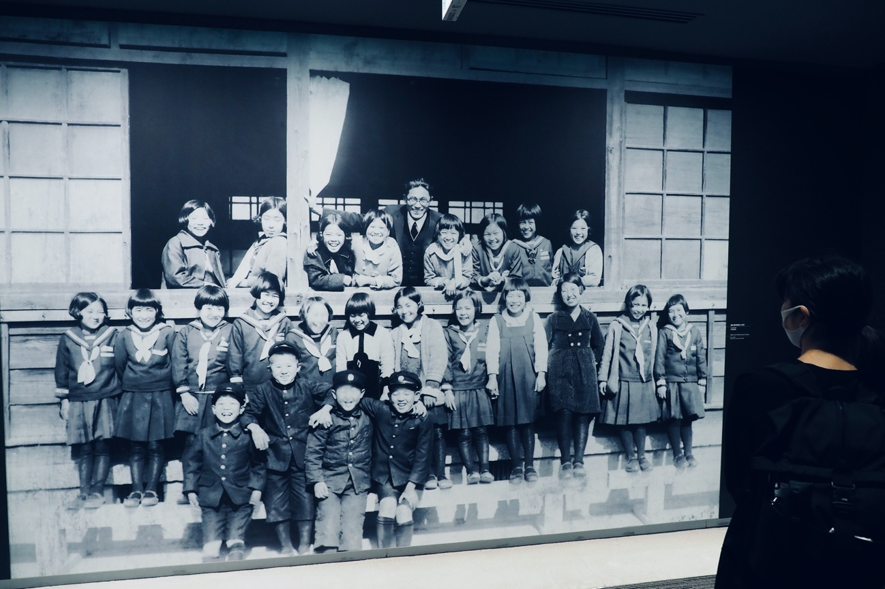
Imai: I’ve been coming here today since I was in junior high school, but I thought I should come back again as an adult. I thought I knew about it, but I didn’t want to know more about it because it would be emotionally painful. But there was a man who wrote in a comment exchange notebook, “Why didn’t I come earlier?” I thought, ‘Oh, that’s true.’
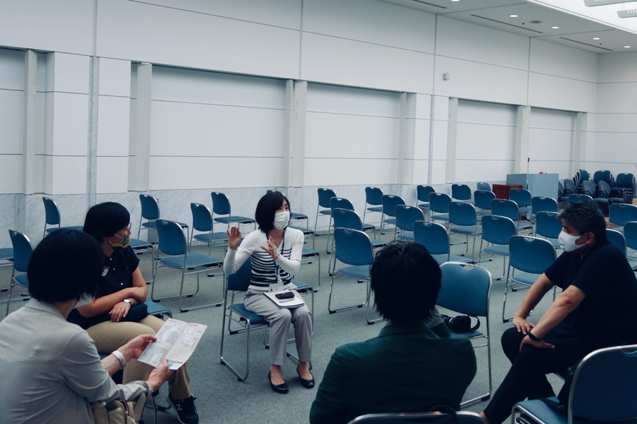
Tanimoto: The nuclear weapons are still around today, not in the distant past. If nuclear weapons are used, the same thing will happen. I want people to think about what they should do and what they can do for the future.
Tanaka: Unless the individual’s consciousness changes, the world won’t change. We have to change ourselves first.
Tanimoto: I have to make people aware of this.
Tanaka: There are so many stages before the world can really become a better place as we think. You have to know, you have to think, you have to change, and then you would make massages, or take action. It would be great if this museum would be the first step in the process of that.
Tanimoto: I think it is the mission of the museum to convey that information correctly.
Tanaka: The only way for people to know what it’s like to be in this shock, is to come here. Can’t we make it compulsory for all humanity? I think everyone should come to see this museum once.
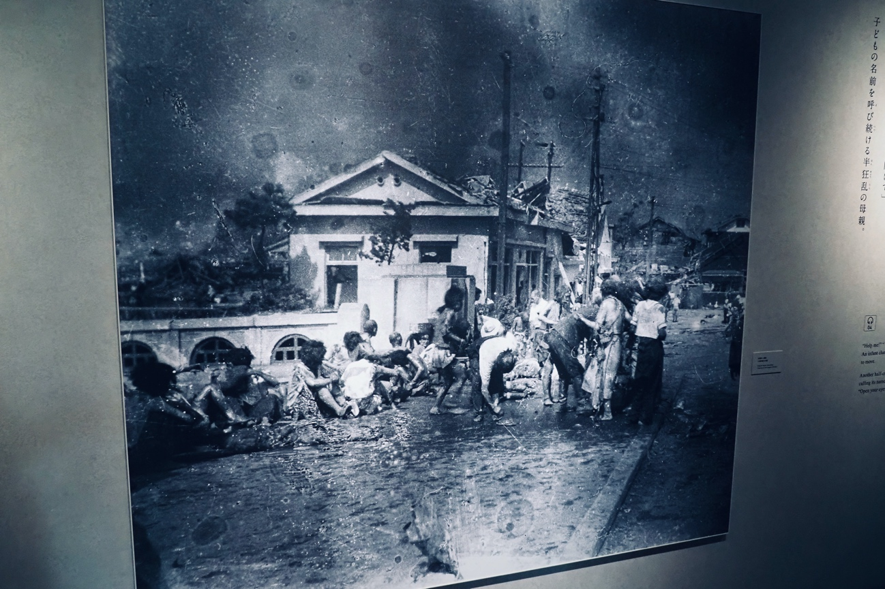
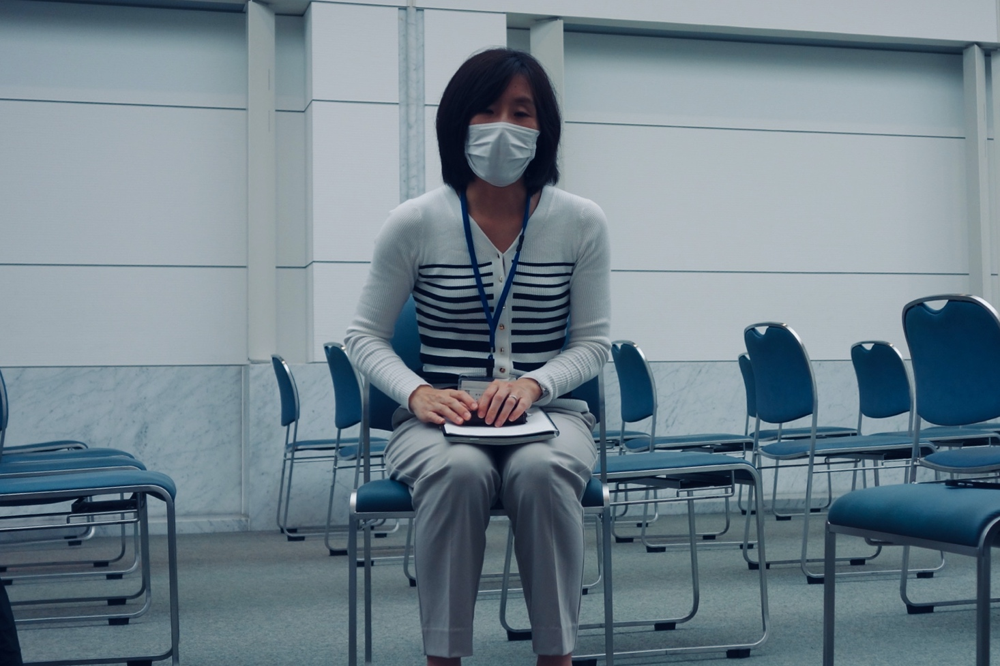
Tanimoto: Yes. That’s an interesting idea. I want all people to think of it as their own problem.
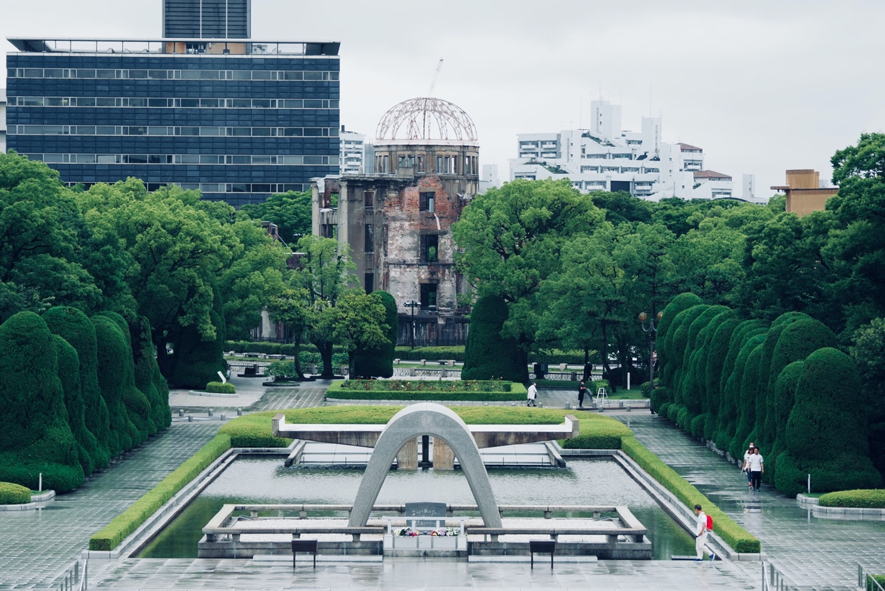
the Dome
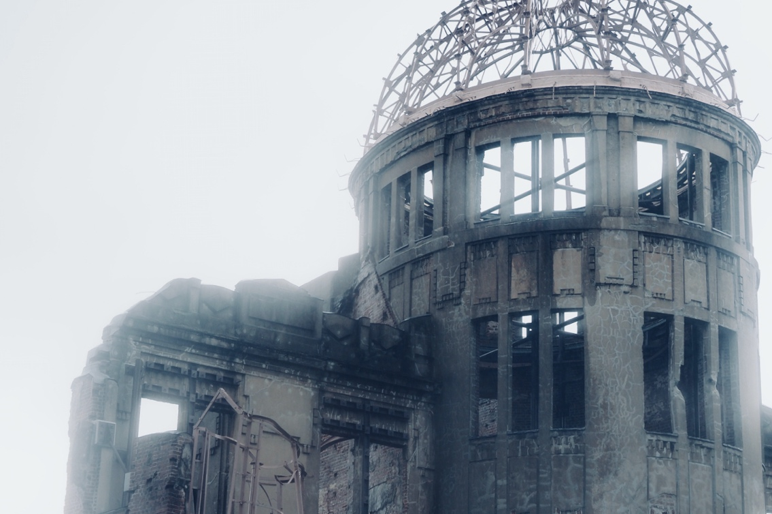
We walked to the Atomic Bomb Dome. Not having any conversation was not only because of the downpour of rain.
A sense of discomfort I felt at the Hiroshima Peace Memorial Museum came to mind.
As I mentioned above, at the museum, we learned the names of the individuals who were victims of the bombing and came face to face with them. But the atomic bomb spoken of is like a natural disaster: August 6, 1945, a terrible thing happened. It sounded, to some extent, as if it was an explanation of a natural disaster.
The museum is not a theme park where people view the horror and sorrow of the disaster. It is not a disaster land.
Of course, for the “innocent” people who lived their daily lives in the city of Hiroshima without engaging the enemy, it may not be any different from a “natural disaster.”
However, the atomic bomb did not “fall.” It was “dropped” by man against man.
KOHNO Fumiyo, who wrote “In This Corner of the World,” has a dying victim quote :
The only thing I know is that someone wanted me to die.(in “Town of Evening Calm, Country of Cherry Blossoms”)
It is up to the viewer to learn about history and the damage and perpetration of war, to learn about them, to compensate for them, and to establish his or her own perspective.
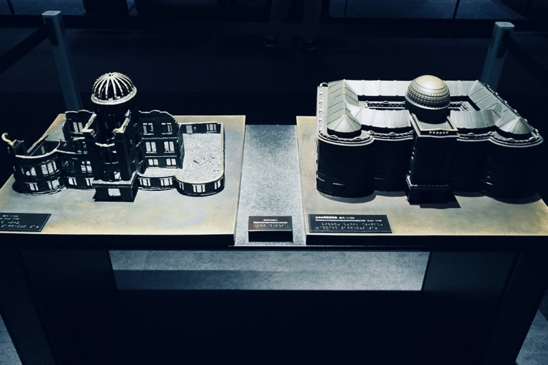
The Atomic Bomb Dome. Before the bombing, it was called the Hiroshima Prefectural Industrial Promotion Hall. The building located at the foot of the Aioi Bridge, which was the target of the bombing, had been a magnificent sight in the prosperous pre-war era of Hiroshima. The area around Hiroshima Peace Memorial Park that we now walk through was once the busiest area in the city.
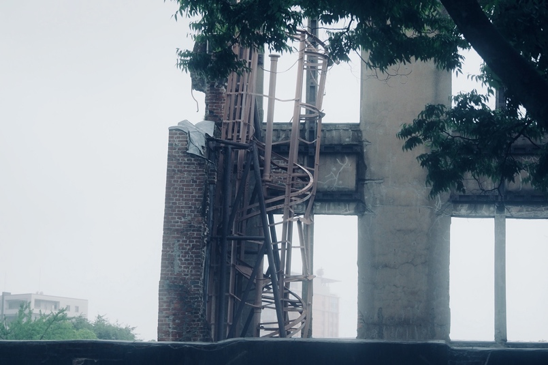
The destroyed Hiroshima Prefectural Industrial Promotion Hall, now known as the Atomic Bomb Dome, has been preserved as best it can, and is a UNESCO World Heritage Site.

The rubble from that time has been preserved.
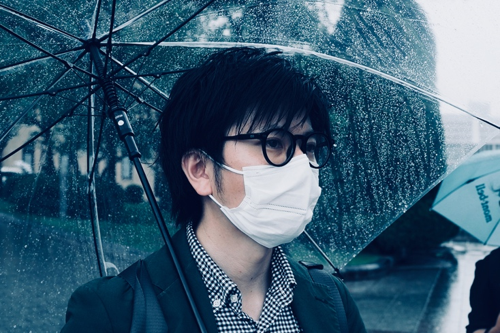
No one, not even Mr. Araki, has spoken.
I suddenly understood why.
What we had seen in the museum was “shame.”
It was what my father had never told me. It was also what my grandfather never told me.
Both he and his father felt guilty about the fact that they had survived by chance.
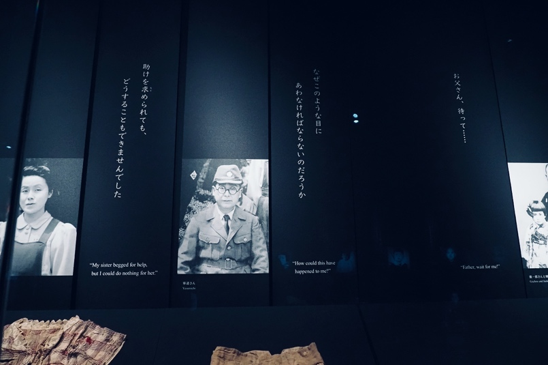
We are ashamed just to have someone take off our clothes at the train station in the morning. We are ashamed just to have been beaten in public and to have our noses bleed.
The people of Hiroshima died having their clothes ripped off, their skin hanging down, bleeding, and burning in flames. They died in shame.
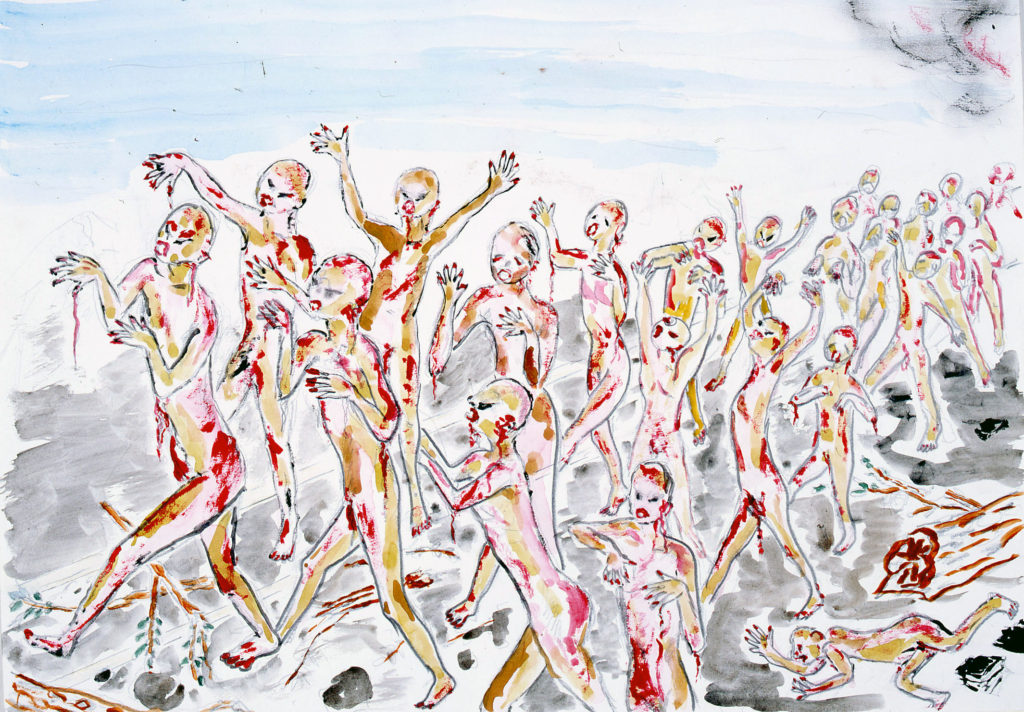
A sense of inexplicable “shame” arose in us when we saw them. They felt ashamed. And we ourselves, just being there, were ashamed too. Shame that we are now living comfortably. It stole the conversation from us. It is not sadness that has silenced us. Nor is it pity. It was someone’s shame, numerous people’s. Shame.
That’s not what natural disasters do. We feel shame only for human deeds. Only man makes a man ashamed.
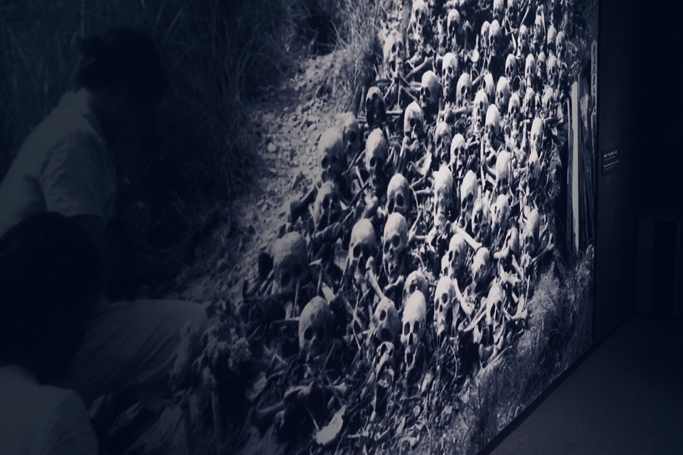
The skin was ashamed.
Blood was ashamed.
Bones were ashamed.

Death forced by someone is a shame.
We would never let anyone, not even ourselves, carry this shame.
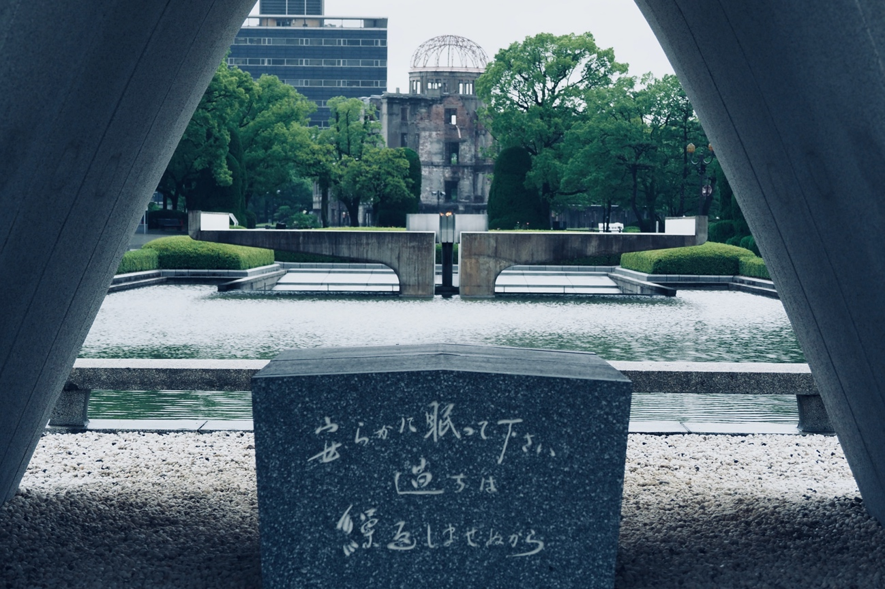
The word, “For we shall not repeat the evil,” also captures my heart and keeps me in suspense. Who is the subject of this word? Is it the governor of Japan? Or the leaders of the enemy? Or the people who live here and now? And what exactly is the evil?
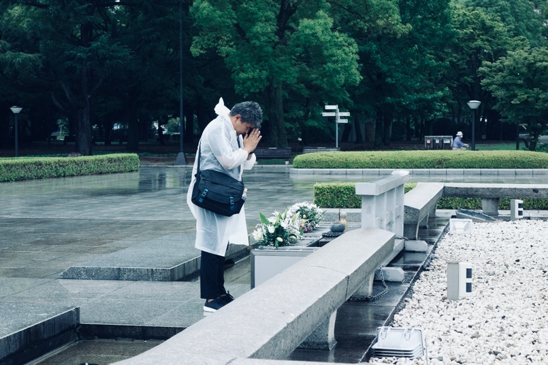
I just stand here with my own view of the world. The word is a riddle to make us ask again and again what it means.
Hiroshimas
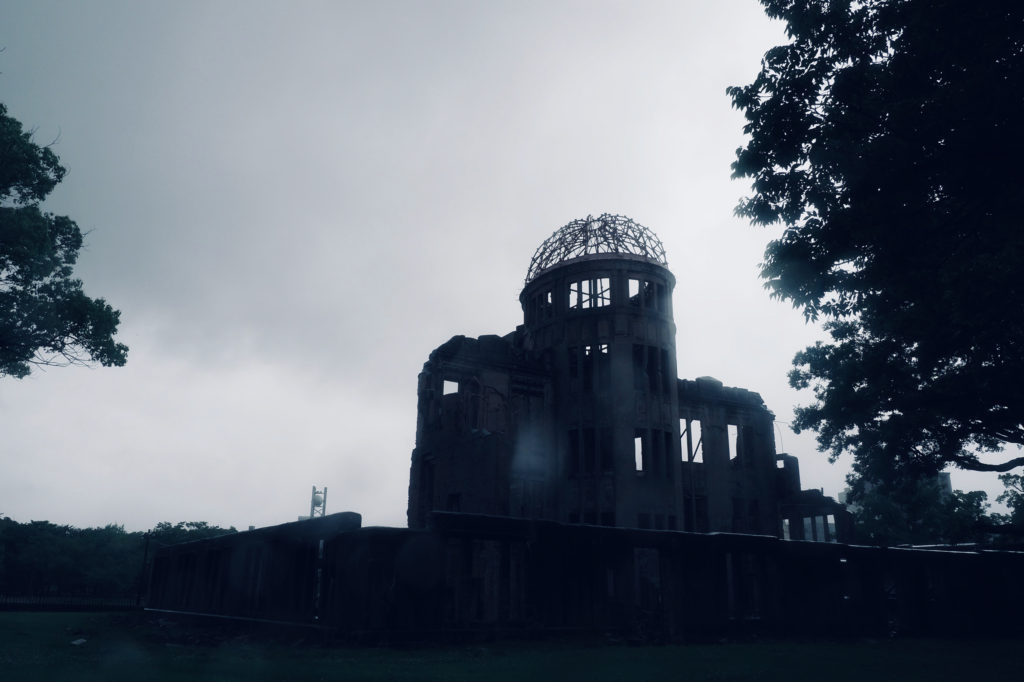
“No more Hiroshimas.” (*a common campaign phrase for abolishing nuclear weapons)
Did you know that the English rendering of this phrase is not “No more Hiroshima”?
In order to claim “Never again should there be a city like Hiroshima,” you should say “No more Hiroshimas.”
Sadly, we know the second atomic bombed city: Nagasaki. We just hope no third city will be counted.
On May 27, 2016, Barack Obama, the 44th president of the United States, visited Hiroshima.
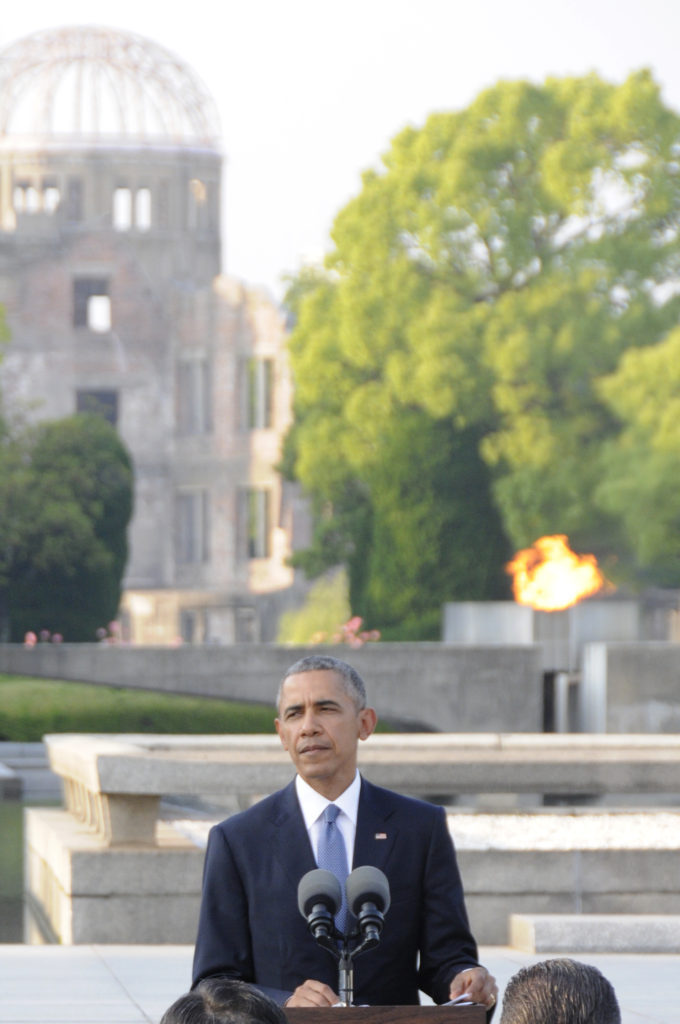
“Seventy-one years ago on a bright, cloudless morning, death fell from the sky and the world was changed.”
After all, he speaks as if it were a natural disaster. There is no apology. That is indeed not to be expected. Still, he did also say thus:
“But among those nations like my own that hold nuclear stockpiles, we must have the courage to escape the logic of fear and pursue a world without them.”
“We may not realize this goal in my lifetime. But persistent effort can roll back the possibility of catastrophe.”
But there was a great contradiction in his inspiring speech. For there stood a soldier with a black briefcase at his side.
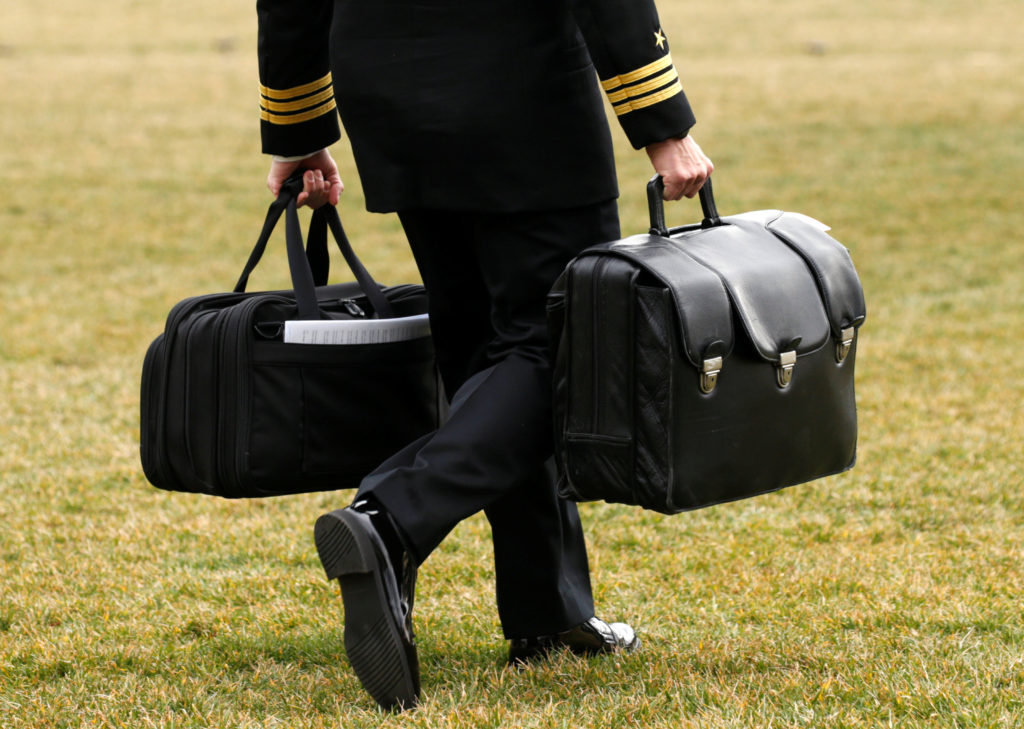
It contained a device that allows the president to authorize a nuclear attack, dubbed the “nuclear football.” On that day, Hiroshima, where the world’s first atomic bomb was dropped, was the launch pad for nuclear weapons. This is a picture of Japan, the only country to have been exposed to the atomic bomb, living under the banner of the U.S. nuclear umbrella.
I cannot blame Japan nor the U.S. for this contradiction. Nor can I cynically denigrate Obama’s wishes as a lie. The President of the United States concluded:
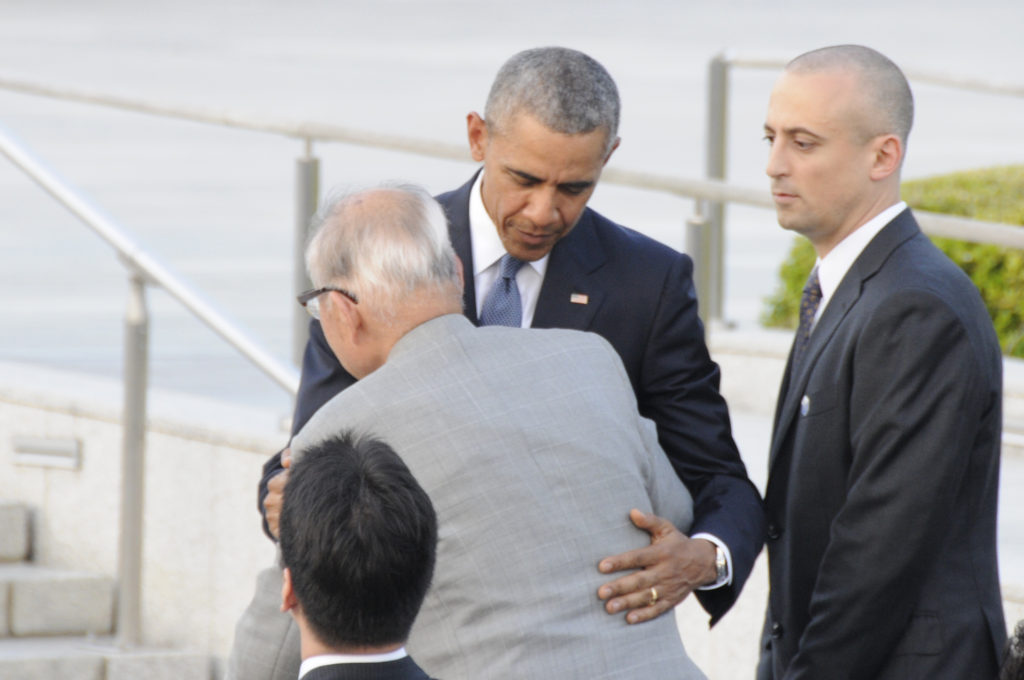
“That is why we come to Hiroshima. So that we might think of people we love — the first smile from our children in the morning; the gentle touch from a spouse over the kitchen table; the comforting embrace of a parent”
We must recognize the feeling, the words, to say yes, you’re right, and I agree.
It may not even be realized in my lifetime. But I can’t help but dream of a world without nuclear weapons.
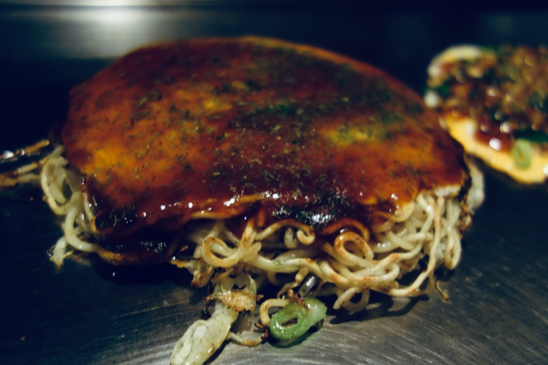
At the end of this long day, we ate some of the local specialties. We all had mixed feelings, but we talked about our day and what we want to do in the future.

Suddenly, in the middle of our conversation, I was so tired that I collapsed into a faint. Ms. Imai, who was sitting across from me, surprised at me and held up her camera.
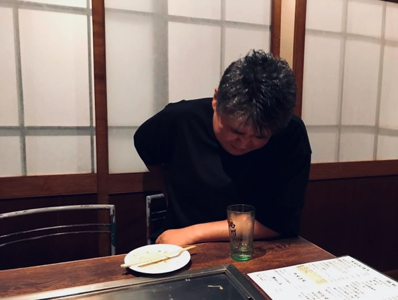
I hit my lower back and scraped a big bit of skin on my elbow. This pain would remain as a “simulation” of my experience, connected to a few hundred-thousandth of a pain and a shame of thousands of bomb victims that I felt at the museum. I believe so.
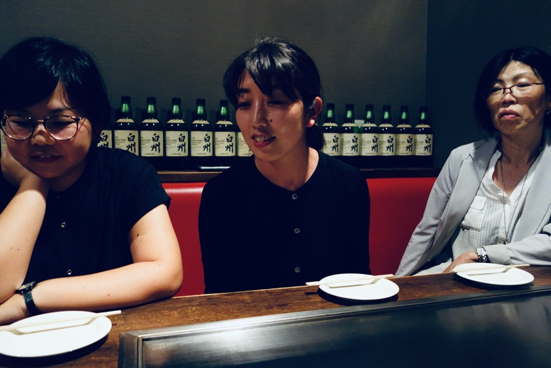
People had kind words for my little “shame.” The people at the restaurant drew a shape on the food they cooked on the griddle.
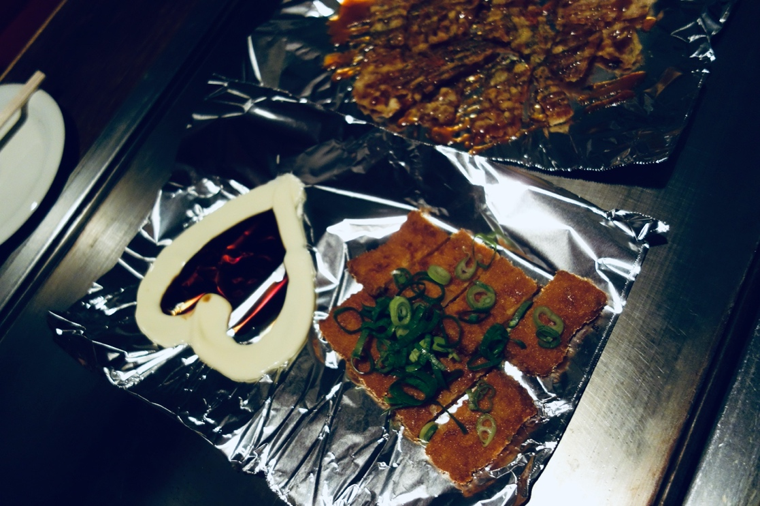
Please Share it with everyone!
Text and photos
TANAKA Hironobu
Born in Osaka, 1969, to a father born in Hiroshima and a mother born in Kagawa.
In 1993, he started to work Dentsu Inc. and worked as a copywriter for 24 years. After retiring, starts to work as a writer. In June 2019, published his first book, “Write what you want to read.”
Tags associated with this article



